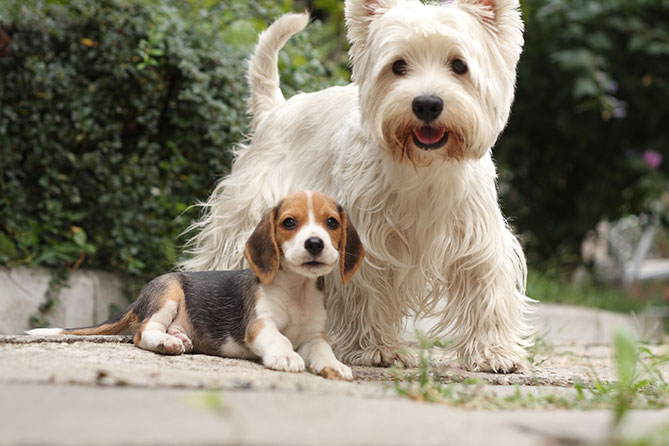For anyone looking to add to their pet family, the addition of a rescue dog will bring years of love and joy. Adoptable pets listed by reliable rescue centres have not only been health-checked, they’ve also been assessed for temperament, basic manners and toilet training. This makes choosing the right pet for your family and lifestyle easy. Rescue dogs are some of the best four-legged friends you can bring home, and they often have incredible stories.
As far as introductions go, dogs are a lot like people. They each have individual communication styles and personal preferences about which dogs they wish to spend time with and which ones they’d rather walk past.
Also like people, first impressions for dogs count, making taking the time to plan the first meeting between your existing dog and your new one crucial. If an initial meeting goes badly, it can take a great deal of effort to reverse the detrimental psychological effects, let alone repair any physical injuries.
Tips for introducing your new dog to your existing dog
1. Be prepared to take it slow
The number one rule when bringing a new dog into a household that already has dogs in it is to do it gradually. The worst mistake people make is to simply bring the dog into the house and expect everyone to get along. To the dogs that were already there, this is an intrusion on their territory by a stranger and to the new dog, being thrust into an unknown environment leaves it without any rules to follow or boundaries to respect.
2. Get home-ready
To get your home ready for the arrival of your new dog, take away all items your current dog might feel protective of. Food dishes, favourite toys, even nests of bedding may cause your dog to react aggressively if he feels he’s being threatened, even if he hasn’t shown these behaviours in the past.
Also clean up any untidiness or clutter, as the dogs may feel pushed together if their space is confined.
3. Start with a walk
Walking is a very primal activity, which was used as a means of migration by the early settlers and our dog’s ancestors. Walking helps form bonds as the dogs ‘migrate’ from point A to Point B.
To introduce your new dog in a neutral territory, you will need the assistance of a family member or friend – someone who is well known to your existing dog. With both dogs on a loose leash, arrange to meet each other in a space where you don’t usually walk your dog and a space that is unlikely to be familiar to your new dog.
Have your friend or family member walk the new dog behind you. After the dogs have burnt off some energy, allow your dog to drop back and let the new dog sniff his behind. Resume the walk, every so often allowing the dogs to have a sniff. Gradually increase their time walking together and let them establish their rapport with as little interference as possible.
Only get in the middle if the dogs begin to fight or tension is obviously mounting – behaviour such as hackle-raising, baring teeth, deep growling, nipping or snapping. Try not to pull on the leash as this may aggravate them more and instead separate them gently.
Return to your walk and repeat the process. When they are in a calm state and walking together without incident, it’s safe to make for home.
4. Let the new dog be ‘invited’
Having got to know each other on their walk, your dogs should now be acquainted. Having arrived home, allow your original dog to enter the home first, then bring your new dog inside after a few moments. This allows your original dog to “invite” the new pack member into the home.
5. Be watchful
For the first few weeks, give the dogs as much outdoor time together as possible, continuing regular walks. Always watch their interactions to monitor how they are getting along. This is especially important in circumstances that might antagonise or excite one or both, such as family members returning home, visitors, meals and play.
6. Allow one-on-one time
While it’s wonderful to have your dogs get along, it’s important to remember that primarily, your dog wants to bond with you – not the other dog. Remember your first dog has established habits they are used to, so keep them going and ensure you offer valuable one-on-one time. Your new dog too wants to establish a healthy relationship with you, so be sure to give him some special You-Time too.
A few final don’ts…
- Don’t introduce a puppy to a grown dog by holding him in your arms. The puppy could feel restrained and vulnerable. Let the puppy instead meet the dog on his terms, on the ground.
- Don’t let your original dog bully the new dog
- Don’t confine both dogs to a small space such as a crate, car boot or room until they are fully comfortable with each other.
- Don’t EVER let two dogs “fight it out”. Following this very bad advice will only lead to a strained long-term relationship.







Leave A Comment